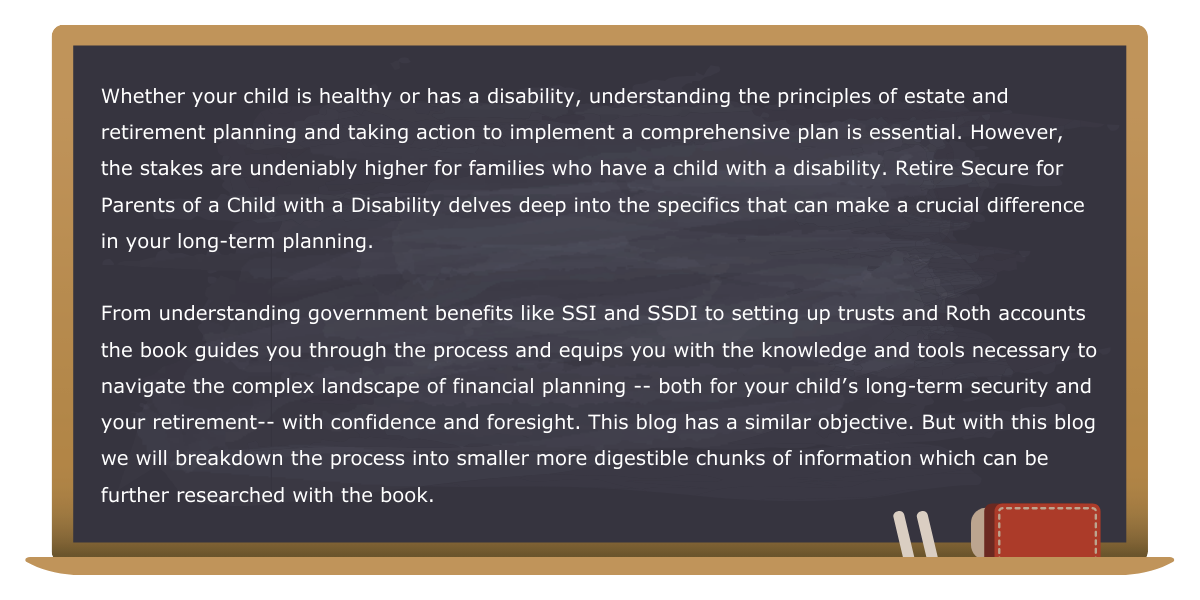Blog for Parents of a Child with a Disability

The Bedrock Principles of Retirement and Estate Planning
Introduction
For the first two first posts, we will preview the most fundamental principles of retirement and estate planning.
Lifecycle Planning for a Child with a Disability
Laying the groundwork early and taking the right steps in the right order is absolutely critical. We have identified three separate stages: (1) Birth to Age 18, (2) Age 18 to Parents’ Retirement, and (3) Parents’ Retirement and Beyond.
Stage 1:
Gather as much documentation as you can on your child’s health circumstances by collecting health records from doctors, early intervention evaluations, and any school records, even if there is no official diagnosis. These records could be invaluable when the time comes to claim benefits.

Gather as much documentation as you can on your child’s health circumstances by collecting health records from doctors, early intervention evaluations, and any school records, even if there is no official diagnosis. These records could be invaluable when the time comes to claim benefits.
This is a very important time to get your child qualified for Medicaid or Medicare. Each state has its own program and its own qualifications so you will need to do that research. Consider setting up an ABLE account if you have an official diagnosis of your child’s disability.
At least a year before you child turns 18 you should begin the process of transition planning and get your estate plan structured. Your estate plan should include a special needs trust for your child so your child can inherit money and retirement accounts without jeopardizing government benefits. Be sure to update the beneficiary designations on all your retirement plans with the appropriate language referencing any trusts.
Stage 2:
As soon as your child turns 18, start the process of assisting your child in applying for Supplemental Security Income (SSI) benefits. If you child became disabled after they began working, they may be eligible for Social Security Disability Benefits on their work record. More often than not, SSDI benefits for a child are based on the parent’s work record not the child’s and that means waiting to apply for SSDI until the parent is eligible for Social Security.
Stage 3:
When thinking about claiming your retirement Social Security benefits, consider switching your child’s benefits from SSI to SSDI. The benefits for SSDI tend to be higher and have fewer strict means-testing restrictions than SSI.
The earliest you can apply for Social Security is at age 62, but the longer you wait the higher your monthly benefits. But under some circumstances it can make sense to apply early. Get help from an experienced advisor to make recommendations based on your specific circumstances.
The Bedrock Principles
Concerted saving for retirement is essential. How to best go about that can be structured on some fundamental principles, the simplest but also the most nuanced is:
Pay taxes later, except for Roth Accounts, Roth IRAs and Roth conversions.
We will delve into the intricacies of the Roth world in later blogs. Or you can immediately read more in our book, Retire Secure for Parents of a Child with a Disability.
The Accumulation Years
Here are our broad recommendations on the hierarchy of contributing to accounts (subject to availability and personal circumstances).
- Take advantage of any employer match.
- Take advantage of a Health Savings Account, if available to you.
- Contribute to Roth IRAs and Roth 401(k)s subject to exceptions based on tax brackets.
- Contribute to an ABLE account for your child.
- Contribute to traditional retirement plans or IRAs.
- Contribute to nondeductible IRAs or other nondeductible retirement plans.
- Save money in a plain old after-tax brokerage account.
Make no bones about it, the cardinal rule of saving for retirement is taking advantage of employer matching contributions. It’s like free money! And recent legislation allows employer matching contributions to go into a Roth or a Traditional account if the plan permits.
In the following figure, two parents with the same tax rates, investments, etc. invest in their retirement differently. The parent represented in the solid black line took advantage of his employer’s retirement plan, even disregarding the match. The parent represented in the dashed line did not take advantage of his employer’s retirement plan.

Detailed assumptions can be found by clicking here.
The parent who used his employer’s plan had $1,118,724 more at age 80 than the person who did not invest in his employer’s plan, even though the amount of money he saved on a tax-adjusted basis was the same and there was no employer match. This figure reflects our basic premise that paying taxes later while you are in the accumulation stage means you can retire richer instead of “broker.”
Health Savings Accounts are only available to those who choose a high deductible health insurance plan. But with an HAS you get a tax deduction, the money grows tax free, and withdrawals are tax free if used for qualifying medical expenses. They are even more advantageous than Roths!
ABLE accounts allow persons who have been certified as disabled to accumulate up to $100,000 without jeopardizing eligibility for government benefits programs.
The Distribution Years
Subject to exception, we recommend you spend money in the following order:
- Spend your income first.
- Spend your after-tax dollars that don’t have any or much appreciation.
- Spend your highly appreciated after-tax dollars.
- Spend your traditional retirement assets like IRAs and 403(b)s.
- Spend your Roth dollars last.
The following figure supports the premise that, subject to exception, you should spend your after-tax dollars before your retirement plan, IRA or Roth dollars.
Please look at the figure that follows. Both retirees start with the same amount of money in a regular brokerage account—which I refer to as after-tax dollars—and in their traditional retirement plans which could be IRAs or 401(k)s. The figure below indicates, subject to exceptions, that most readers should spend their after-tax dollars first and then IRA and retirement plan dollars. The solid line shows what happens to the first retiree who spends after-tax dollars first and withdraws only the minimum from the IRA when required to (more on RMDs in the next section). He paid taxes later. The dashed line shows what happens to the second retiree who spends his IRA before his after-tax dollars. He paid taxes now.

Detailed assumptions can be found by clicking here.
The Accumulation Years
The only difference between the dashed line and the solid line in this figure is that the first retiree retained more money in the tax-deferred IRA for a longer period. Even starting at age 65, the decision to defer income taxes for as long as possible gives the first retiree an extra $340,199 if he or his spouse lives to age 89. If one of them lives longer, paying taxes later will be even more valuable to them.
As a rule of thumb, deferring income taxes due on your retirement plans for as long as possible and generally holding off on spending your Roth dollars will benefit you and your family.
Conclusion
Even for a first installment, this is a lot of information to digest. But building a strong financial foundation is critical for the whole family, and first steps will set the journey in motion. The next installment in this blog will introduce some of the positive and negative impacts of the SECURE Act on retirement savings legacy planning, explain the basics of required minimum distributions (RMD), and the delve into some of the reasons to plan now to take advantage of relatively low tax rates. If any particular topic catches your attention, remember a full discussion is available in our book Retire Secure for Parents of a Child with a Disability.
Figure 1.2: Spend the Right Money First*

